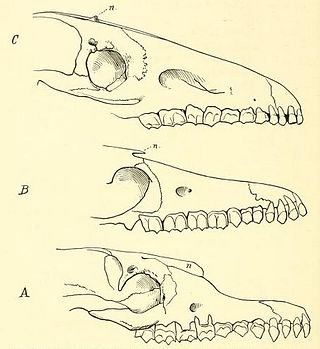
Odd-toed ungulates, mammals which constitute the taxonomic order Perissodactyla, are animals—ungulates—that have reduced the weight-bearing toes to three or one of the five original toes. The nonweight-bearing toes are either present, absent, vestigial, or positioned posteriorly. By contrast, the even-toed ungulates bear most of their weight equally on four or two of the five toes: their third and fourth toes. Another difference between the two is that odd-toed ungulates digest plant cellulose in their intestines, rather than in one or more stomach chambers as even-toed ungulates, with the exception of Suina, do.

Tapirs are large, herbivorous mammals belonging to the family Tapiridae. They are similar in shape to a pig, with a short, prehensile nose trunk. Tapirs inhabit jungle and forest regions of South and Central America and Southeast Asia. They are one of three extant branches of Perissodactyla, alongside equines and rhinoceroses. Only a single genus, Tapirus, is currently extant. Tapirs migrated into South America during the Pleistocene epoch from North America after the formation of the Isthmus of Panama as part of the Great American Interchange. Tapirs were formerly present across North America, but became extinct in the region at the end of the Late Pleistocene, around 12,000 years ago.

The South American tapir, also commonly called the Brazilian tapir, the Amazonian tapir, the maned tapir, the lowland tapir, the anta (Portuguese), and la sachavaca, is one of the four recognized species in the tapir family. It is the largest surviving native terrestrial mammal in the Amazon.

Tapirus is a genus of tapir which contains the living tapir species. The Malayan tapir is usually included in Tapirus as well, although some authorities have moved it into its own genus, Acrocodia.

Macraucheniidae is a family in the extinct South American ungulate order Litopterna, that resembled various camelids. The reduced nasal bones of their skulls was originally suggested to have housed a small proboscis, similar to that of the saiga antelope. However, one study suggested that they were openings for large moose-like nostrils. Conversely, prehistoric pictographs by indigenous people seems to depict animals interpreted as macraucheniids with trunks. Their hooves were similar to those of rhinoceroses today, with a simple ankle joint and three digits on each foot. Thus, they may have been capable of rapid directional change when running away from predators, such as large phorusrhacid terror birds, sparassodont metatherians, giant short-faced bears (Arctotherium) and saber-toothed cats (Smilodon). Macraucheniids probably lived in large herds to gain protection against these predators, as well as to facilitate finding mates for reproduction.

Stegomastodon is an extinct genus of gomphotheres, a family of proboscideans. It ranged throughout North America from the early Blancan ~4 Ma, to the early Irvingtonian. The South American species have been synonymized with Notiomastodon platensis.

Xenorhinotherium is an extinct genus of macraucheniine macraucheniids, closely related to Macrauchenia of Patagonia. The type species is X. bahiense.

The giant tapir is an extinct species of tapir that lived in southern China, Vietnam and Laos, with reports suggesting it also lived in Taiwan, Java, and potentially Borneo. The species has been recorded from Middle and Late Pleistocene. There is only weak evidence for a Holocene survival. Tapirus augustus was larger than any living tapir, with an estimated weight of about 623 kilograms (1,373 lb). The species was also placed in its own genus of Megatapirus, however, it is now conventionally placed within Tapirus.
Coloniatherium is a meridiolestid mammal from the Late Cretaceous of Argentina. The single species, Coloniatherium cilinskii, was a large member of the family Mesungulatidae.

Tapirus californicus, the California tapir, is an extinct species of tapir that inhabited North America during the Pleistocene. It became extinct about 13,000 years ago.
This paleomammalogy list records new fossil mammal taxa that were described during the year 2011, as well as notes other significant paleomammalogy discoveries and events which occurred during that year.
Leptoptilos patagonicus is an extinct species of large-bodied Leptoptilini stork that existed during the Late Miocene. Fossils of the species were discovered in the San Madryn Formation in Chubut Province, Argentina. L. patagonicus is the first fossil record discovery of a member of Leptoptilos in South America and the only one found so far in the New World.

Tapirus veroensis is an extinct tapir species that lived in the area of the modern eastern and southern United States during the Pleistocene epoch (Irvingtonian-Rancholabrean). Tapirus veronensis is thought to have gone extinct around 11,000 years ago.
Tapirus cristatellus is an extinct species of tapir from the Pleistocene of South America. Remains are known from Brazil, specifically the states of Minas Gerais and Bahia.
Tapirus greslebini is an extinct species of tapir that lived in South America during the Pleistocene.
Tapirus oliverasi is likely an invalid extinct species of tapir from South America.
Tapirus rioplatensis is an extinct species of tapir that lived in South American swamps and forests during the Pleistocene and was probably the ancestor of all South American tapirs alive today.
Tapirus rondoniensis is an extinct species of large sized tapir that lived in northwestern parts of Brazil during the Pleistocene. Fossils of the species were found in the Río Madeira Formation of Rondônia, after which the species is named.

Trichechus hesperamazonicus, the western Amazonian manatee, is an extinct species of manatee that lived about 40 thousand years ago in the Madeira River, in the Brazilian state of Rondonia. It is known from this single locality, with possible occurrences in the Brazilian state of Acre.









